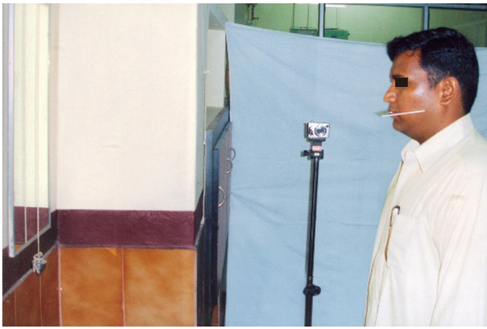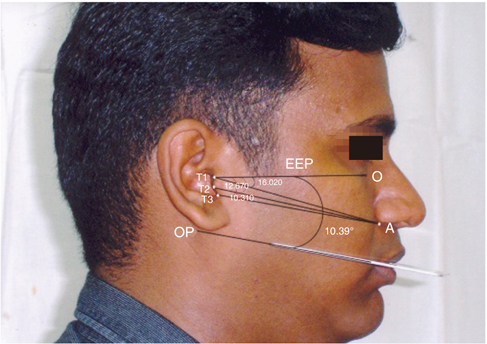J Adv Prosthodont.
2013 Feb;5(1):9-15. 10.4047/jap.2013.5.1.9.
A determination of occlusal plane comparing different levels of the tragus to form ala-tragal line or Camper's line: A photographic study
- Affiliations
-
- 1Department of Prosthodontics and Maxillofacial Prosthetics, Surendera Dental College & Research Institute, Sri-Ganganagar, Rajasthan, India. mdssandy07@gmail.com
- 2Department of Prosthodontics and Maxillofacial Prosthetics, M M Institute of Dental Sciences, Mulana, India.
- 3Department of Orthodontics, Surendera Dental College & Research Institute, Sri-Ganganagar, Rajasthan, India.
- KMID: 2284766
- DOI: http://doi.org/10.4047/jap.2013.5.1.9
Abstract
- PURPOSE
The purpose of this study was to determine accurately the part of the tragus to be used to form the Ala-Tragal line or Camper's line in orthognathic profile patients.
MATERIALS AND METHODS
150 dentate subjects with age of 18-40 years with orthognathic profile were sampled. Life-size lateral digital photographs of the face with fox plane were taken in natural head position. Different angles between Eye-Ear plane and occlusal plane (OT1-OP), Eye-Ear plane and ala-superior border of tragus (OT1-AT1), Eye-Ear plane and ala-middle border of tragus (OT1-AT2) and Eye-Ear plane and ala-inferior border of tragus (OT1-AT3) were calculated using computer software package, AutoCAD 2004. From the three angles formed by the Eye-ear plane (OT1 or FH plane) and the ala-tragal lines, the one closest to the angle formed between Eye-Ear plane (OT1) and occlusal plane (OP) was used to determine the occlusal plane of orientation. The obtained results were subjected to ANOVA F test, Tukey's Honestly significant difference test, followed by Karl Pearson coefficient of correlation test. P values of less than 0.05 were taken as statistically significant.
RESULTS
The mean of base line angle i.e. OT1-OP angle (11.96 +/- 4.36) was found to be close to OT1-AT2 angle (13.67 +/- 1.93) and OT1-AT3 angle (10.31 +/- 2.03), but OT1-OP angle was found to be more closer to OT1-AT3 angle. Comparison of mean angles showed that OT1-OP angle in both males (11.68) and females (12.51) is close to OT1-AT3 angle (males- 11.01, females- 11.95).
CONCLUSION
The line joining from ala to the lower border of the tragus was parallel to the occlusal plane in 53.3% of the subjects. There was no influence of the sex on the level of occlusal plane.
Keyword
Figure
Reference
-
1. Terrell WH. Fundamentals important to good complete denture construction. J Prosthet Dent. 1958. 8:740–752.2. Monteith BD. A cephalometric method to determine the angulation of the occlusal plane in edentulous patients. J Prosthet Dent. 1985. 54:81–87.3. Chaconas SJ, Gonidis D. A cephalometric technique for prosthodontic diagnosis and treatment planning. J Prosthet Dent. 1986. 56:567–574.4. Boucher CO. Discussion of laws of articulation. J Prosthet Dent. 1963. 13:45–48.5. Karkazis HC, Polyzois GL. Cephalometrically predicted occlusal plane: implications in removable prosthodontics. J Prosthet Dent. 1991. 65:258–264.6. Augsburger RH. Occlusal plane relation to facial type. J Prosthet Dent. 1953. 3:755–770.7. Hall WA Jr. Important factors in adequate denture occlusion. J Prosthet Dent. 1958. 8:764–775.8. Nagle R, Sears VH. Denture Prosthetics. 1962. 2nd ed. St. Louis: The CV Mosby;134–136.9. Yasaki M. The height of occlusal rim and the interocclusal distance. J Prosthet Dent. 1961. 11:26–31.10. Simon PW. Fundamental principles of a systemic diagnosis of dental anomalies. 1926. Boston: Stratford Company;242.11. Lundström F. Registration of natural head posture in children. Swed Dent J Suppl. 1982. 15:147–152.12. Solow B, Tallgren A. Natural head position in standing subjects. Acta Odontol Scand. 1971. 29:591–607.13. Gavan JA, Washburn SL, Lewis PH. Photography: an anthropometric tool. Am J Phys Anthropol. 1952. 10:331–353.14. Baumrind S, Frantz RC. The reliability of head film measurements. 1. Landmark identification. Am J Orthod. 1971. 60:111–127.15. Cooke MS, Wei SH. The reproducibility of natural head posture: a methodological study. Am J Orthod Dentofacial Orthop. 1988. 93:280–288.16. DiPietro GJ, Moergeli JR. Significance of the Frankfortmandibular plane angle to prosthodontics. J Prosthet Dent. 1976. 36:624–635.17. Downs WB. Analysis of dentofacial profile. Angle Orthod. 1956. 26:191–212.18. Hartono R. The occlusal plane in relation to facial types. J Prosthet Dent. 1967. 17:549–558.19. van Niekerk FW, Miller VJ, Bibby RE. The ala-tragus line in complete denture prosthodontics. J Prosthet Dent. 1985. 53:67–69.20. Karkazis HC, Polyzois GL, Zissis AJ. Relationship between Ala-tragus line and natural occlusal plane. Implications in denture prosthodontics. Quintessence Int. 1986. 17:253–255.21. Swenson MG. Complete Dentures. 1947. 2nd ed. St. Louis: The CV Mosby Company;177–180.22. McGee GF. Tooth placement and base contour in denture construction. J Prosthet Dent. 1960. 10:651–657.23. Sloane RB, Cook J. A guide to the orientation of the plane of occlusion. J Prosthet Dent. 1953. 3:53–65.24. L'Estrange PR, Vig PS. A comparative study of the occlusal plane in dentulous and edentulous subjects. J Prosthet Dent. 1975. 33:495–503.25. Landa LS. Practical guidelines for complete denture esthetics. Dent Clin North Am. 1977. 21:285–298.
- Full Text Links
- Actions
-
Cited
- CITED
-
- Close
- Share
- Similar articles
-
- Cephalometrically assessing the validity of superior, middle and inferior tragus points on ala-tragus line while establishing the occlusal plane in edentulous patient
- Faculty-supervised measurements of the face and of mandibular movements on young adults
- The relationship among reference lines used for taking the extraoral radiography
- Relationships between maxillofacial morphology and oral function on the habitual and non-habitual chewing sides
- Identifying the Origin of Zygomaticus Major Muscle Using Soft and Hard Tissue Landmarks





